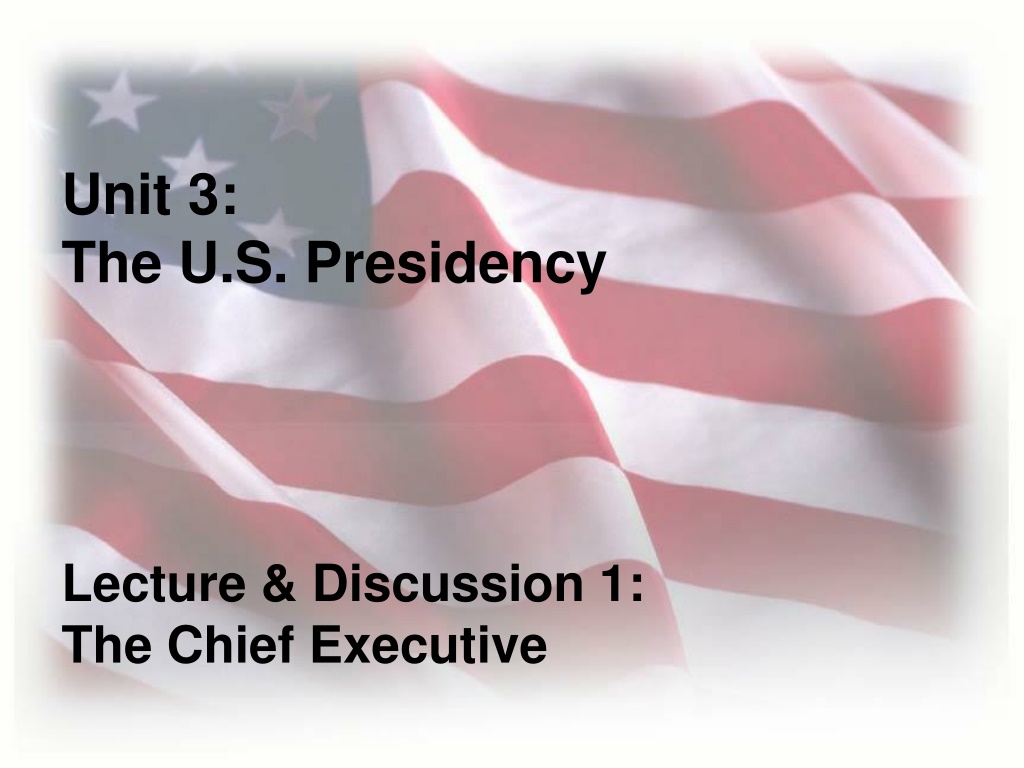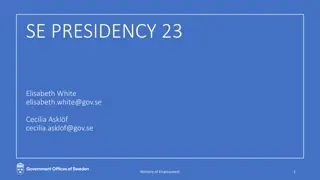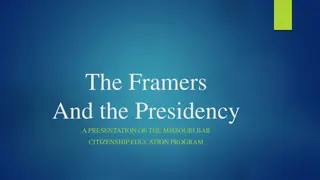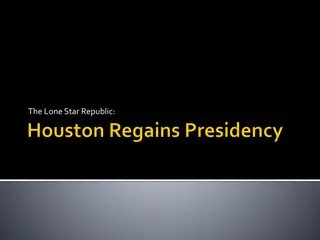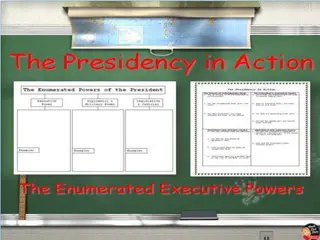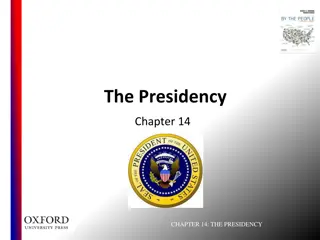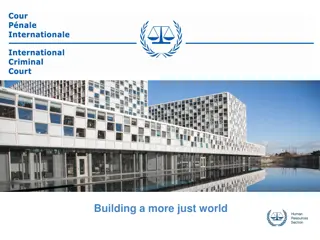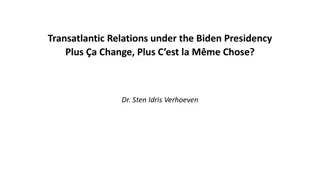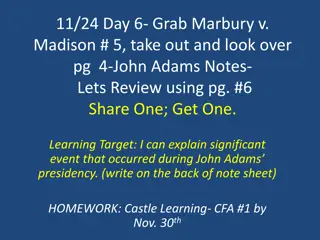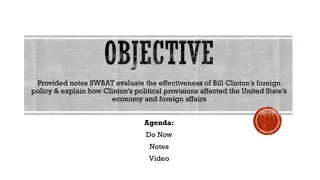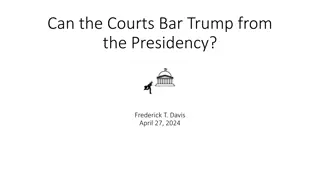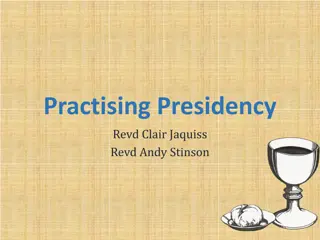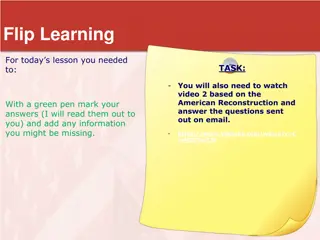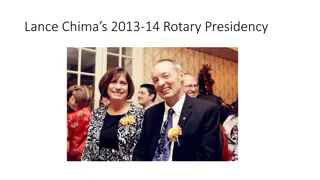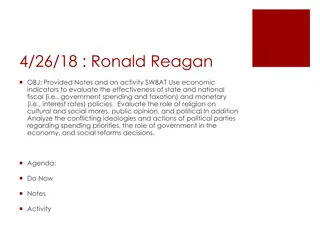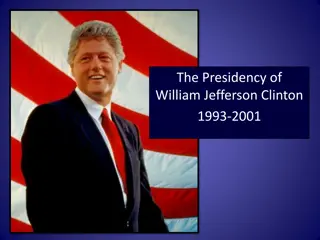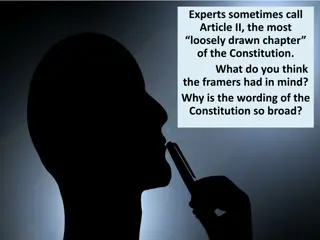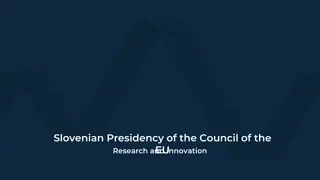Understanding the U.S. Presidency: Roles and Structure
Explore the establishment of the executive branch in the U.S., including the role of the President, qualifications required, informal expectations, and key terms related to the presidency. Delve into the intricate balance of powers and responsibilities within the executive branch, alongside discussions on term limits, bureaucracy management, and the history of Article II of the Constitution. Engage with essential questions on presidential management and the intricate web of support systems for the President.
Download Presentation

Please find below an Image/Link to download the presentation.
The content on the website is provided AS IS for your information and personal use only. It may not be sold, licensed, or shared on other websites without obtaining consent from the author. Download presentation by click this link. If you encounter any issues during the download, it is possible that the publisher has removed the file from their server.
E N D
Presentation Transcript
Unit 3: The U.S. Presidency Lecture & Discussion 1: The Chief Executive
Do Now Watch the intro to the video Article II of the U.S. Constitution (0:00-5:27) and answer the prompts. 1. What is established in Article II? 2. What options did the framers consider when they created the executive branch? 3. What were their concerns about concentrating authority in one person? Why did they do so? The framers were concerned about creating a monarchy. A plural executive failed under the Articles. A single President would be better for executing laws and assigning responsibilities. Article II establishes the executive branch, including the office of the President, who is eligible for that role, how they get elected, and their powers. framers considered an executive council and a President who answered to a separate council Before establishing a single executive, the https://www.khanacademy.org/humanities/ap-us- government-and-politics/interactions-among-branches-of- government/roles-and-powers-of-the-president/v/article-ii- of-the-constitution
Political Dictionary Record the following terms. Electoral College Amendments 22 & 25 Presidential Succession Act administration & federal bureaucracy White House staff (e.g. chief of staff) Executive Office of President (e.g. OMB, NSC) executive departments & cabinet (e.g. State, Defense, Education, Homeland Security) independent agencies (e.g. NASA, CIA, EPA)
Essential Question Record and consider possible responses to the essential question. How does the President both manage and receive assistance from the vast bureaucracy in the executive branch?
Introduction Before deciding on a term of four years for the President, the framers considered several options including a term of seven years and life. With this in mind, respond to the prompts. 1. In your opinion, what is the appropriate term for POTUS? Explain. 2. Do you believe in term limits for the President? Why or why not?
Reading Notes Read Chapter 13.2: Chief Executive 1. Complete the table to identify the formal qualifications of the President. The Constitution requires the President to be Qualification Description Age 35 years of age Citizenship natural born citizen Residency 14 years in United States
Reading Notes Read Chapter 13.2: Chief Executive 2. What are the informal qualifications to be President? Americans tend to like presidents who are white middle-aged wealthy, educated, Christian men
Reading Notes Read Chapter 13.2: Chief Executive 3. What is the Electoral College? A body of electors from each state who cast votes to elect the president and vice president of the United States
Reading Notes Read Chapter 13.2: Chief Executive 4. What is a president s term in office?
Reading Notes Read Chapter 13.2: Chief Executive 5. How is presidential succession determined? Section 1: In the event of death, resignation, or removal from office, the Vice President becomes President Section 2: In the event of a vacancy, the President chooses the Vice President
Reading Notes Read Chapter 13.2: Chief Executive 5. How is presidential succession determined? Section 3: In the event the President notifies Congress in writing he can no longer perform the duties, the Vice President becomes President Section 4: In the event the VP and majority of cabinet notify Congress in writing the President can no longer perform the duties, the Vice President becomes President
Reading Notes Read Chapter 13.2: Chief Executive 5. How is presidential succession determined?
Reading Notes Read Chapter 13.5: The Organization of the Executive Branch 6. Complete the diagram to identify and explain the four main groups of the executive branch. White House Staff Executive Office of President Executive Departments Independent Agencies
Reading Notes Read Chapter 13.5: The Organization of the Executive Branch 6. Complete the diagram to identify and explain the four main groups of the executive branch. White House Staff: President s closes aides who are typically drawn from the campaign staff and longtime associates most powerful is chief of staff staff is NOT subject to Senate confirmation oversee the political and policy interests of the President from the West Wing of White House
Reading Notes Read Chapter 13.5: The Organization of the Executive Branch 6. Complete the diagram to identify and explain the four main groups of the executive branch. Executive Office of the President (EOP): agencies that report directly to the President, but are not located in White House aim to carry out specific goals of administration positions are filled by presidential appointment subject to Senate confirmation key agencies include OMB, CEA and NSC
Reading Notes Read Chapter 13.5: The Organization of the Executive Branch 6. Complete the diagram to identify and explain the four main groups of the executive branch. Executive Departments: departments that carry out the work of government in broad areas of public policy, such as defense heads of departments are filled by presidential appointment subject to Senate confirmation department secretaries form the presidential cabinet, whose influence has diminished over time
Reading Notes Read Chapter 13.5: The Organization of the Executive Branch 6. Complete the diagram to identify and explain the four main groups of the executive branch. Independent Agencies: agencies that do not fall within executive departments, but answer directly to the President leadership positions are filled by presidential appointment subject to Senate confirmation agencies such as NASA, CIA and FDA help to implement federal policy
Processing Research the current president s White House Staff. Who are his closes aides? 1. Chief of Staff: 2. Director of Communications: 3. Press Secretary: 4. White House Counsel: 5. Staff Secretary: 6. Special Assistants:
